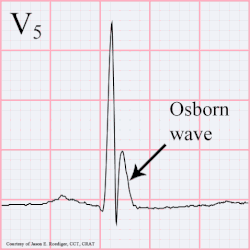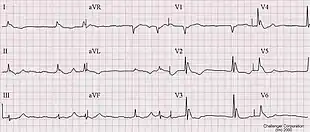

A J wave — also known as Osborn wave, camel-hump sign, late delta wave, hathook junction, hypothermic wave,[1] K wave, H wave or current of injury — is an abnormal electrocardiogram finding.[2]
J waves are positive deflections occurring at the junction between the QRS complex and the ST segment,[3][4] where the S point, also known as the J point, has a myocardial infarction-like elevation.
Causes
They are usually observed in people suffering from hypothermia with a temperature of less than 32 °C (90 °F),[5] though they may also occur in people with very high blood levels of calcium (hypercalcemia), brain injury, vasospastic angina, acute pericarditis, or they could also be a normal variant.
History
The prominent J deflection attributed to hypothermia was first reported in 1938 by Tomaszewski. These waves were then definitively described in 1953 by John J. Osborn (1917–2014) and were named in his honor.[6] Over time, the wave has increasingly been referred to as a J wave, though is still sometimes referred to as the Osborn wave in most part due to Osborn's article in the American Journal of Physiology on experimental hypothermia.[7]
References
- ↑ Aydin M, Gursurer M, Bayraktaroglu T, Kulah E, Onuk T (2005). "Prominent J wave (Osborn wave) with coincidental hypothermia in a 64-year-old woman". Tex Heart Inst J. 32 (1): 105. PMC 555838. PMID 15902836.
- ↑ Maruyama M, Kobayashi Y, Kodani E, et al. (2004). "Osborn waves: history and significance". Indian Pacing Electrophysiol J. 4 (1): 33–9. PMC 1501063. PMID 16943886.
- ↑ "ecg_6lead018.html". Retrieved 2008-12-20.
- ↑ "THE MERCK MANUAL OF GERIATRICS, Ch. 67, Hyperthermia and Hypothermia, Fig. 67-1". Retrieved 2008-12-20.
- ↑ Marx, John (2010). Rosen's emergency medicine: concepts and clinical practice 7th edition. Philadelphia, PA: Mosby/Elsevier. p. 1869. ISBN 978-0-323-05472-0.
- ↑ Osborn, J. J. (1953). "Experimental hypothermia: Respiratory and blood pH changes in relation to cardiac function". Am J Physiol. 175 (3): 389–398. doi:10.1152/ajplegacy.1953.175.3.389. PMID 13114420.
- ↑ Serafi, S.; Vliek, C.; Taremi, M. (2011). "Osborn waves in a hypothermic patient". Journal of Community Hospital Internal Medicine Perspectives. 1 (4). Article: 10742. doi:10.3402/jchimp.v1i4.10742. PMC 3714046. PMID 23882340.